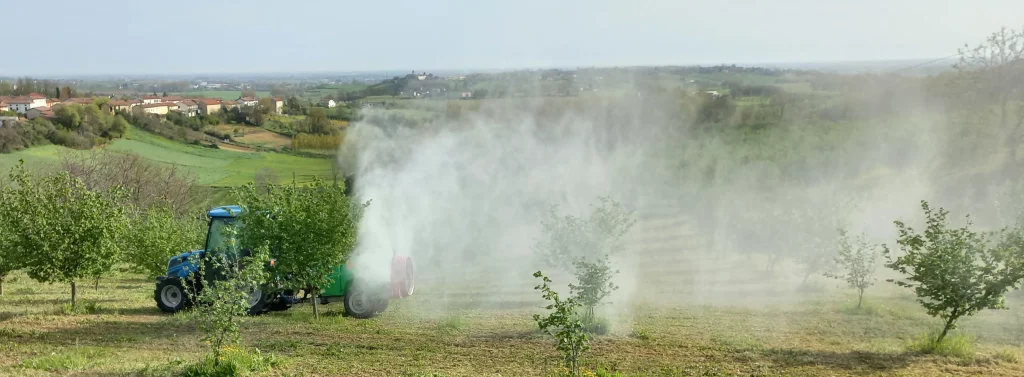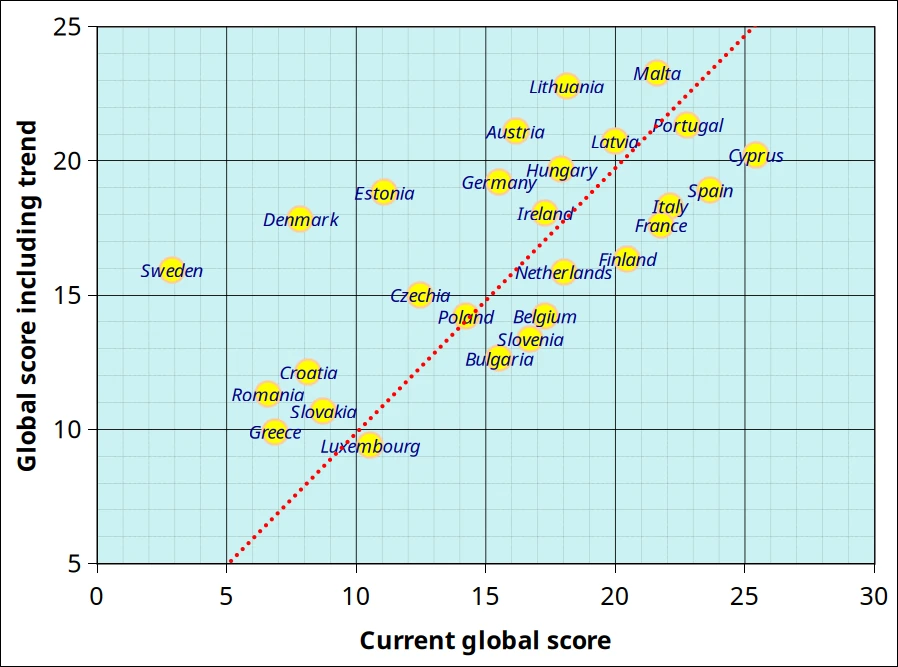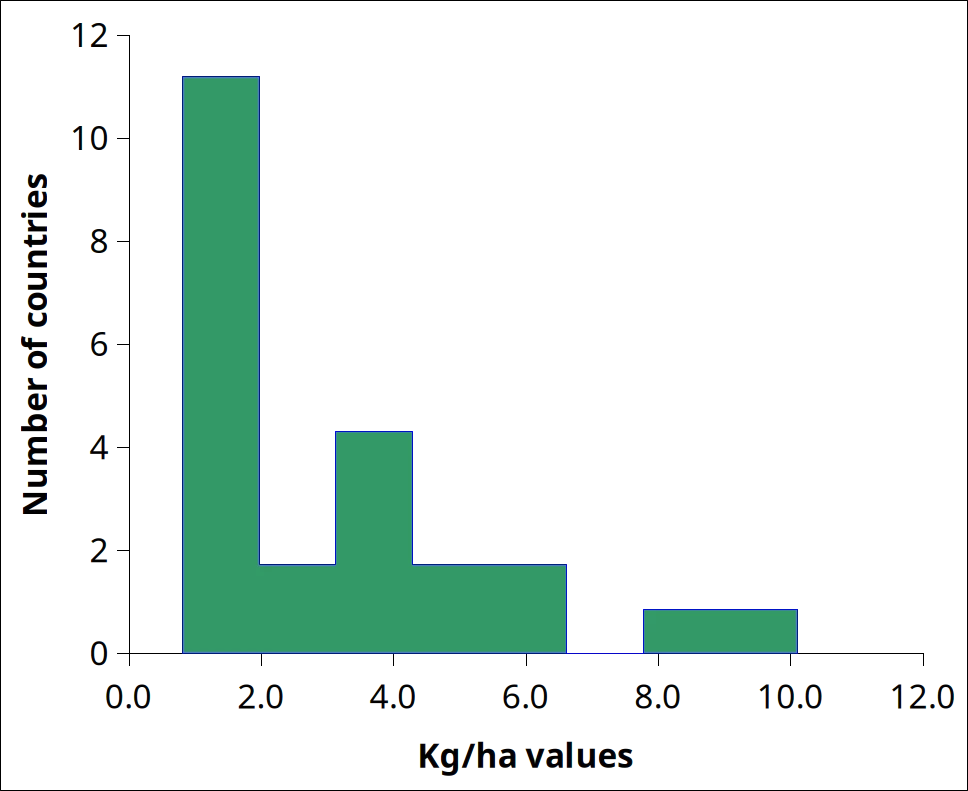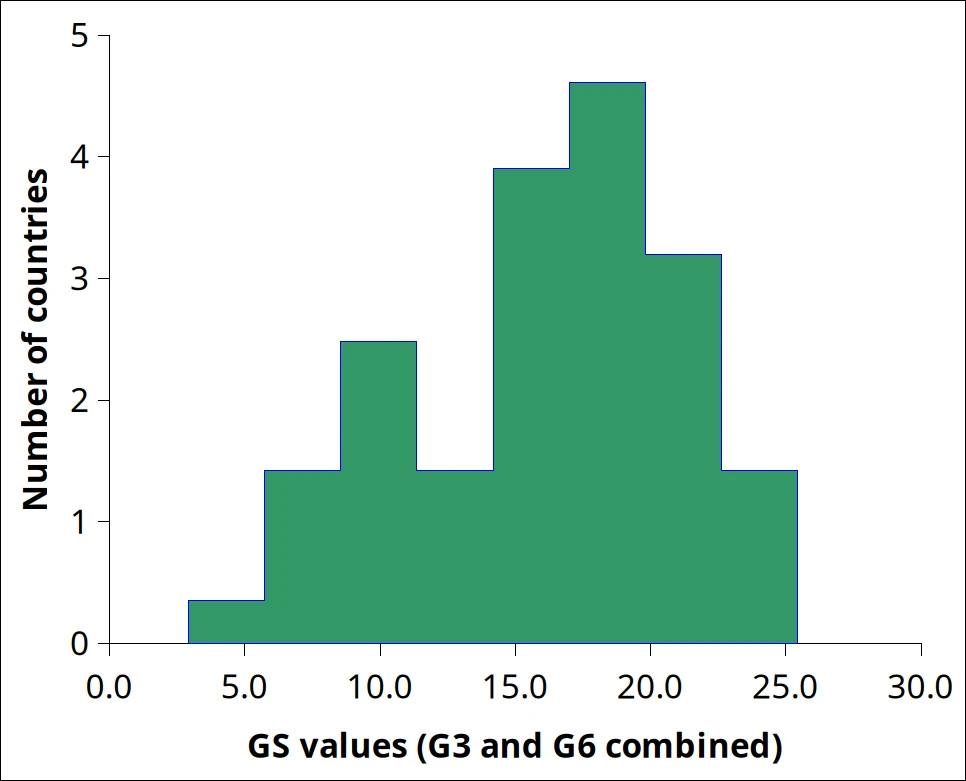There is a simplified companion to this post entitled More about pesticides in the European Union. The companion was prepared because readers complained that Table 2 below makes difficult reading, especially the colour coding of percentiles. Compared with the present post, the companion also has an additional new map attempting to show how pesticide use varies within countries.

Introduction

According to FAOSTAT2, in the five years from 2018 to 2022, the USA used just under 466000 tonnes of pesticides on average annually. This is about 3.0 Kg/ha and 1.4 Kg for every American. In the 27 EU countries (Table 1), pesticide use reached a slightly lower value of about 350000 tonnes. In terms of pesticide use per ha, EU countries consume 3.5 Kg/ha, slightly more than the USA, but significantly less on a per capita basis (0.63 Kg/capita)3.
Without entering into much country-specific detail, fungicides, bactericides and herbicides make up about 75% of all pesticides, with insecticides reaching about 20%. Other pesticides, including rodenticides, make up less than 10% of total use.
Who in Europe uses most pesticides?
Table 2 provides some detail of pesticide use at country level by listing three variables averaged over 2018-2022 as well as their trends during the same period: Kg pesticide used/ha, Kg pesticide use/capita and g of pesticide per International $ (Int$). g of pesticide per International $ is the quantity of pesticide used to produce one US$ of value of agricultural product. In other words, it is a measure of pesticide use efficiency: a low value means that relatively little pesticide is used.
The average value listed in the table is the average of the values… in the table; it does not take into account the vastly different levels of productions between different countries. The true EU average is 0.97 g/Int$. For comparison, the US consumes 1.25 g/Int$.
The colour coding used in Figure 2 is provided below and explained in more detail in the text.


All variables in table 2 are coded in such a way that “low” means “good or improving” and “high” means “bad or worsening”5. The qualifiers are seen from an environmental and human health point of view and not necessarily in terms of agricultural desirability or production. The table is arranged according to decreasing pesticide per hectare.
The top 25% largest consumers of pesticides cover 7 countries from Portugal (5.09 kg/ha) to Italy, Ireland, Belgium, Netherlands, Cyprus6 and eventually Malta (10.10 Kg/ha). It is stressed, however, that Malta does hardly produce any field crops, the agricultural sector being oriented towards fisheries, some livestock including poultry, and some vegetables (especially potatoes) and grapes. Refer to the Maltese 2020 Census of agriculture report for details. Malta’s large pesticide consumption is in line with other areas focusing on horticultural crops.
With Cyprus, however, although we are dealing with a minor agricultural producer, the combined summer and winter cereals cereal output in the range of 2 to 2.5 million tonnes per annum, which is an output comparable with such countries as Greece, Latvia, and Belgium, and more than double than the Netherland’s cereal output.
Among the most “virtuous” countries, we have a group of Scandinavian and Baltic states with Slovakia, none of which is ranked among the major producers in Europe, with the exception of Romania, almost on par with Germany (both countries with an output of about 25 million tonnes of cereals) and second only to France (about 50 million tonnes cereals output).
Among the highest pesticide uses capita, we can list Spain and France and, again, Cyprus. Low values occur, again, in Sweden and Slovakia, but Latvia and Lithuania are faring badly, as the countries are clearly trying to improve their outputs by increasing fertiliser consumption. Malta is doing well as a result of the very limited agricultural area and mostly urban population.
The third columns, g of fertiliser per $, could be interpreted as a “fertiliser tax” consumers of agricultural products have to pay to producers. In other words, the cost of the agricultural products includes a relatively large share of pesticide in Cyprus, Portugal and Finland. Environment-conscious customers should understand that, not only are they exposed to higher levels of pesticides; they even have to pay for it!
Trends
Columns 4 to 6 in Table 2 list recent trends7 in the same variables as those in columns 1 to 3. While recognizing that trends based on 5 years may not be very robust statistically (See, however, note 11), they nevertheless provide an indication whether things have been changing to the better or the worst between 2018 and 2022.
We have a marked contrast between the eastern and the western Mediterranean, Cyprus and Malta.The second keeps trying reducing their dependence on imports, especially for fresh products. The first, however, appears to be actively reducing pesticide consumption. The same applies to Belgium, italy Spain, Slovenia and Finland.
Portugal keeps worsening and so do Austria, Germany, Denmark, Lithuania and Estonia.
Overall (synthetic) assessment
Since an overall assessment is difficult with three variables (Kg pesticide/ha, Kg pesticide/capita and g of pesticide per Int$), I have replaced them with a synthetic index8 referred to as Global score (GS), the underlying methodology of which is explained in the footnote9. Suffice it to mention that the GS is an index that gives relatively more weight to negative variables, i.e. one dark spot in an rosy landscape will deteriorate the whole landscape. For instance, the score based on (2, 2, 2)10 is naturally 2, but the one obtained for (1, 2 and 15) is 10.4 (the arithmetic mean would be 6.0).
The current discussion refers to the GS3, i.e. the GS based on 2018-2022 averages of the three first variables. If we consider GS3 values above 20 values as “bad” scores, we have to list Cyprus, Spain, Portugal, Italy, France and Finland as the worst offenders. Strictly, Malta should be included but, given the very unusual agriculture practiced in the island, their inclusion would be unfair. The bolded countries include the major cereal producers in Europe and their contribution to environmental and human health degradation is thus significant.
On the other hand, there are several much more environment-friendly major producers and exporters of agricultural products including Germany and Bulgaria (GS3=15.5), Poland (GS3=14.2) and especially Romania (GS3=6.6). In fact, Romania is the only state in the European Union that is, at the same time, a major agricultural country and a country that uses pesticides sparingly. Other environment-friendly countries with GS3 scores below 10 include Slovakia, Croatia, Denmark, Greece and Sweden next to the already mentioned Romania.
And the immediate future?

The GS3 was calculated using recent 2018-2022 averages, as mentioned above. Within the limits of the caveat already mentioned for a trend based on 5-years11, if we include the 3 trend variables, we define a new GS, GS6. Since GS6 also includes trends it should, to some extent shows where we are headed.
Figure 3 illustrates how GS changes between GS3 and GS5. The dotted line indicates “no change”; the countries close to the line retain their “generally good and environmentally-friendly” status (Luxembourg, Poland) or their “mixed” (Ireland) or bad performance (Latvia, Portugal).
Below the line, the situation is improving for some of the poor performers including the pack that includes Finland, France, Italy and Spain (they all gain more than 4 GS points) , as well as the poorest pupil in the class, Cyprus, which loses as much as 5.2 GS points (from GS3=25.4 to GS6=20.2). This is still bad, but Cyprus should overtake Portugal, another poor performer, in environment-friendliness.
A marked deterioration occurs for two groups:
- some of the good performer in south-eastern Europe, including Croatia, Slovakia, Greece and Romania (they lose 3.5 GS points on average), but the countries remain nevertheless among the most eco-friendly;
- “nordic” countries including Lithuania (-4.6), Estonia, Denmark and Sweden which are on course of losing an average of 8.6 GS points.
Among the major producers, things get worse in Hungary (17.9 to 19.7) and Germany (15.5 to 19.6).
Summary
There is a large disparity among European Union countries in terms of pesticide use. The present analysis takes the approach that “little pesticide is good for the environment and for people”, regardless of any agronomic considerations. According to FAO statistics, about 350000 tonnes of pesticides are used annually by European farmers. Three quarters are fungicides, bactericides and herbicides and about one fifth is insecticides (about 60000 tonnes). Since pesticide use can be expressed using different variables (such application rate per hectare, or kg per capita), an index (referred to as “global score”, GS) was defined to synthesize overall fertiliser use, in such a way that high values mean “bad” and low means “environment and people friendly”.
The worst scores are achieved, as a group of 6 countries including Cyprus, Portugal and Finland, as well as 3 countries that are among the main agricultural exporters in Europe: France, Italy and Spain. Other major exporters are doing much better, including Germany, Poland and Bulgaria, with average GS values.
A group of “nordic countries” (Denmark, Sweden) and a group of “SW European countries” (Slovakia, Croatia, Greece) both use little pesticides, but the absolute champion is Romania with one of the lowest pesticide uses in Europe while being at the same time the third agricultural country, just after France and Germany.
An attempt was made to look at the situation in the immediate future by using recent pesticide use trends. The result is that the bad (except Portugal) may well improve; some average pesticide users will probably remain so (Poland). Deterioration may be moderate in the the SW European group (including Romania), but most significant in the north (Sweden, Denmark, Estonia). Germany will also undergo some negative changes, but not to the extent of the Scandinavian and Baltic states.
References
Froment A, L. Nef 1976 Méthodes d’évaluation écologiques des zones vertes comme base pour la gestion de l’environnement et la conservation de la nature. Les Naturalistes Belges, 57(1):2-26.
Van der Maarel E 1970 Biologische evaluatie van natuur en landschap ten dienste van natuurbehoud en milieubeheer. Groeten uit Holland, lnst. Voor Natuurbeschermingseducatie, Amsterdam, 10-19.
Van der Maarel E 1971 Florastatistieken ais bijdrage tot de evaluatie van natuurgebieden. Gorteria, 5(7-10): 176-188.
Notes
- This a direct application of the practice of privatizing profit and socializing risk. There is ample literature on the subject, from the financial system to nuclear reactors. ↩︎
- All data in this post were extracted from FAOSTAT. The latest data available at the time of writing are those of 2022 . Detailed methodological information and definitions are available from this document on the FAOSTAT website. ↩︎
- FAOSTAT also lists pesticide use per value of agricultural production. The values are 1.25 and 0.90 for the US and the EU, respectively, expressed in g of pesticide/$. ↩︎
- Clearly, the top and bottom 10% are included as well in the top and bottom 25%) ↩︎
- It is also stressed that all variables are affected by a positive skew, as is also indicated by the fact that averages are larger than the medians (bottom lines in Table 2). This is to say that most values of the variables in Table 2 are grouped at low values, and that there is a small number of large values that “pull up the mean”. This illustrated by the histogramme below for Kg of pesticide used per ha.

Figure Note 5: absolute frequency distribution 27 Kg pesticide/Ha values. ↩︎ - I have always been a staunch supporter of the accession of Türkiye to the European Union. One of the arguments against the country has been the fact that only a small part lies in Europe (3% of the land, but 15% of the population). Other motivations, which are more difficult to rationnalise, include fear (of the economic weight of Türkiye, of Islam) and plain racism. In retrospect, it has been a better bet for Türkiye to focus on it’s Turkic hinterland. The specific reason why I am mentioning Türkiye in this context is because Cyprus is not in Europe at all: it is a West Asian country. Culture and Geography clash as well in Georgia, Armenia. ↩︎
- Trends were determined using the SLOPE spreadsheet function. ↩︎
- There is a whole corpus of literature (should I say “science”?) about indices. The Wikipedia link sees them mainly as statistically defined beings, but there is much more to it. This other Wikipedia link about scaling comes closer to many real-life indices. It is possible to list some desirable properties indices in terms of linearity of response, statistical behaviour, robustness against arithmetic manipulation etc. The Figure below shows that, compared with the Kg pesticide per ha variable (Figure Note 5), the calculations that lead to GS result in a more symmetrical distribution. This means, among others, that the concept of average is meaningful for GS, while it is not for Kg pesticide per ha. Using indicators rather than “native unprocessed variables” can thus have the welcome side effect that statistics become more meaningful.

Figure Note 8: Absolute frequency distribution of 54 GS values. ↩︎ - Methodology used to compute the Global ranking. The variables Kg/ha, Kg/cap and g/Int$ were first replaced by their rank, from 1 to 27. For Kg/ha, Malta is recoded as 27 and Sweden as 1. The three values were then cubed, added and averaged and the cubic root taken. This is a procedure developed by the Dutch plant sociologist Eddy van der Maarel (Van de Maarel 1970, 1971) and used in ecological landscape element assessments: an element is ranked as valuable when it is valuable for at least one factor, e.g. a nesting tree of a rare bird is valuable even there are some negative factors (e.g. a rubbish dump) nearby. Another example of the application of van de Maarel’s formula can be found in Froment and Nef (1976) ↩︎
- Meaning Kg pesticide/ha=2, Kg pesticide/capita =2 and g of pesticide per Int$=2. ↩︎
- Under conditions of rapidly changing climate, the question of the reference period for comparisons and trends is a tricky one. I have already mentioned the fact in my footnote 14 on the post on the NW Italian Popillia outbreak. When it comes to trends, it is obvious that – among others – market and environmental (including climatic) conditions trigger farmers’ adaptation, and that adaptation is measured by trends at the national level. It may be argued that longer trends, i.e. 15 year-based, have mixed drivers and that short ones are more likely to capture the immediate future. ↩︎